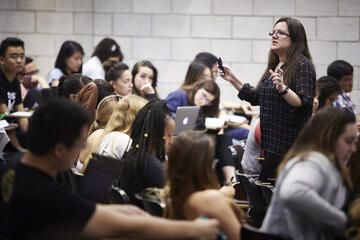Priming the STEM workforce pipeline just requires recruiting students with an aptitude for science and math and giving them scholarships to keep at it, right?
Not quite, according to Jenifer Utz in the School of Life Sciences and fellow professors Christy Strong, Katie Rafferty, and Frank van Breukelen.
Their program — Developing the Skill and Will to Succeed in STEM — is proving that it takes a broader approach to carry talented students through to graduation and early career success.
Their Succeed in STEM program attracted a Scholarships in Science, Technology, Engineering, and Mathematics Program (S-STEM) grant through the National Science Foundation (NSF). In the first three years of the grant, they awarded scholarships to 36 students and launched activities to support their recruitment, retention, and graduation.
Evaluation through the program’s first three years is promising — showing a better than 90% retention rate for the students directly enrolled in the program. Not only are these students staying at UNLV, they are also staying in their programs within the life sciences.
“Students who enter the program with little confidence in their abilities end up changing the scope of their future,” Utz said. “They learn about resilience, how to improve their skills and abilities for future endeavors, and tackle leadership opportunities they might not have without the guidance and resources of this program.”
The NSF clearly sees the progress, as Utz and her colleagues have been awarded a new grant to continue their work for the next six years. In total this brings $2.1 million to UNLV in support of this program.
But perhaps the biggest payoff for UNLV is that the program is having an effect beyond those direct participants. It's also enhancing teaching and bringing new career-readiness resources to all Life Sciences students.
Connecting STEM Learning to Broader Career Possibilities
In addition to scholarships, the Succeed in STEM participants receive individualized mentorship from both faculty and more advanced peers. They are invited to monthly dinners that incorporate workshops on topics from resume building, to mock interviews, to managing a professional online presence. One workshop covered virtual interviewing, a crucial skill since the Covid pandemic.
The Succeed in STEM program team also organized career panels initially focused on Life Sciences students. Their most recent panel was opened to the entire college, and future plans include keeping these open to all sciences students. Hearing from and interacting with industry experts gives students a broader idea of what careers are available to them after graduation.
“Once the students can see a variety of potential career paths, it helps to drive their engagement and keep them focused on succeeding,” says Utz.
“My favorite part of participating in the program was definitely the career exploration panels. Everyone from doctors, crime scene analysts, park rangers, and even librarians came to these panels to tell us about their work,” said undergraduate Jose Llanes, who entered the program in 2021 and then found himself researching more about career paths once the panels were over. “Each of these professionals gave us a window into their lives and I am grateful they were part of the program.”
Sophomore Melika Cummings, who also entered the program in 2021, said "The career exploration panels allow scholars insight into careers that I personally did not know existed.”

Improving Teaching in the Classroom
The Succeed in STEM team is collaborating with fellow faculty, especially in introductory courses, to improve learning outcomes. Courses that were delivered primarily in a long format lecture, for example, are being adapted to include more active learning tools, such as practice questions and open response sessions that encourage participation from students.
Utz started this journey with a researcher in the College of Education back in 2014. Matt Bernacki – an expert in educational psychology focusing on learning technologies and analytics, motivation, and personalized learning – was looking at how to embed tools within online learning platforms like Canvas to improve learning outcomes for students. Using data-driven tools to identify struggling STEM students early in the semester allowed faculty to provide learning support to improve their study habits and class performance.
Bernacki is now at University of North Carolina at Chapel Hill, but their work to improve STEM teaching for UNLV students didn’t stop. It’s evolving through the Succeed in STEM program.
Where to From Here?
Currently the Succeed in STEM program’s direct services are only open to students in the School of Life Sciences, but organizers hope to scale the program to the entire College of Sciences and beyond.
“This program can go a long way to making STEM education more engaging for students from diverse backgrounds who might not have thought a STEM field was right for them,” Utz notes.
Six more years of funding will allow the team to continue to build out this extensive support system for students. Creating a learning environment that encourages growth, mentorship, and a community that makes students feel more supported, has proven to be beneficial to outcomes.
“This program has given me the confidence to succeed in my studies by offering resources both inside and outside the classroom, as well as having a space where I could talk about my struggles and get help through faculty and peer mentors,” says Llanes.
Cummings credits the program with opening up a greater network of academics and professionals for her to interact with. She is currently working as an undergrad researcher with Jingchun Chen, associate research professor for the Nevada Institute of Personalized Medicine (NIPM).
“The pool of opportunities seems minimal when one does not have a network of professionals,” Cummings says. “The Succeed in STEM program became the network in which I saw opportunity.”
The NSF money will eventually run out, but the impact of those funds will be exponential in what has been accomplished. Improving introductory courses in biology to engage students and retain them. Providing activities to open students’ eyes to potential careers in these fields. Retaining and graduating students who are passionate about their potential.
Llanes plans to apply to the Kirk Kerkorian School of Medicine at UNLV once he graduates, and he credits this program with helping him prepare for and understand the application process.
Cummings also plans to pursue a career in medicine with a focus in clinical neurodegenerative research. She intends to apply to a MD/PhD program and to one day be a well-versed pediatric neurosurgeon.
“As a low-income, first-generation student, having this opportunity to work with other high achieving scholars to explore careers and refine my scientific perspective has meant the world to me," Cummings said.
Learn how to apply for the Developing the Will and Skill to Succeed in STEM program.
About S-STEM
S-STEM is a NSF program created to support higher education institutions with scholarship funding for low income students of talent. Grant awardees must put activities in place which support recruitment, retention and graduation of students in STEM. The School of Life Sciences started their S-STEM program in 2018.



